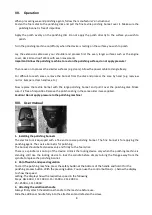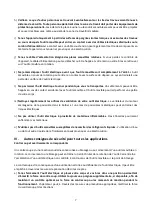
5
b)
Wear protective equipment while using the device, always wear protective eyewear.
Wearing
personal protective equipment such as a dusk mask, nonslip safety shoes, hard hat or hearing protection
in keeping with the type of electric tool and its application will reduce the risk of injury.
c)
Prevent unintentional operation, make sure the electric tool is turned off before connecting it to the
power supply, picking it up or carrying it.
Carrying the electric tool with your finger on the switch or
connecting the device to the power supply while it is turned on can lead to accidents.
d)
Remove adjustment tools or wrenches before turning on the electric tool.
A tool or wrench attached
to a rotating device component can result in injury.
e)
Avoid abnormal posture. Make sure you have good footing and keep your balance at all times.
Doing
so will increase your level of control over the electric tool in unexpected situations.
f)
Wear suitable clothing. Do not wear loose clothing or jewelry. Keep your hair, clothing and gloves
away from moving parts.
Loose clothing, jewelry or long hair may be caught in moving parts.
g)
Where dust exhaust or collection equipment can be used, make sure it is connected and in correct use.
Use of dust exhaust equipment can reduce dust-related hazards.
4) Using and handling electric tools
a)
Do not overload the device. Use the appropriate electric tool for the task at hand.
With the
appropriate electric tool, you will work with greater speed and safety in the indicated power range.
b)
Do not use an electric tool if its switch is defective.
Any electric tool that can no longer be turned
on/off is hazardous and should be repaired.
c)
Disconnect the plug from the power outlet before making device adjustments, changing accessory
parts or laying aside the device.
This safety measure prevents the electric tool from starting up
unintentionally.
d)
Store electric tools out of the reach of children during periods of disuse. Do not allow any persons to
use the device who are not familiar with it or have not read this user manual.
Electric tools are
hazardous in the hands of inexperienced persons.
e)
Take good care of your electric tools. Verify that all moving parts are working without fault and do not
stick, check for broken or damaged parts that may impair the electric tool's functionality. Have
damaged parts repaired before continued use.
Many accidents are caused due to poorly maintenanced
electric tools.
f)
Keep cutting tools sharp and clean.
Carefully maintained cutting tools with sharp cutting edges seize
less frequently and are easier to guide.
g)
Use your electric tool, all accessories, insertion tools, etc. according to these instructions. Take the
working conditions and the task at hand into account.
The use of electric tools for applications other
than the intended purpose can lead to hazardous situations.
















































